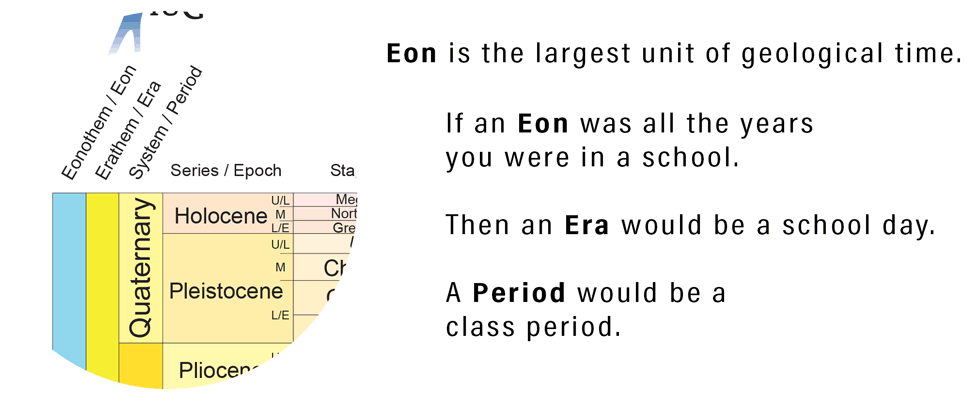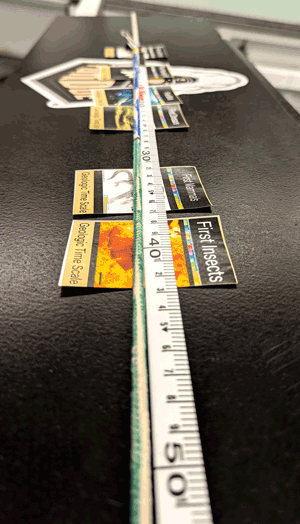Geologic Time Scale
Chronology is the science of organizing events in the order they happened in time.
Introducing Timelines
What are some events that all of us have had in our lives?
- Ask the class "What are some events that all of us have had in our lives?"
- Make a list of 5 or 6 things on the board.
Let’s organize these!
- We like to arrange things in the order that they happen. So, let’s make a timeline of events of our events.
- Have the class help organize things in the order that they happen. Write it as a timeline on the board.
- I like to use a meter stick and be very intentional with my spacing to model time as a scale. I also avoid using the far right of the space to infer time existed before their lives.
A Timescale is a scale used to represent periods of time.
- Option: Have students make a timeline of their lives in their notebooks. Have them include at least 3 events from the class list and at least 3 events not on the class list. I have my students use a ruler to space years accordingly.
Geologic Timescale
Explain that scientists also like to sort events in the order they have happened. Show the geologic timeline.
OK, that looks overwhelming at first! Let's break it down.
First, see the names of the columns?

An Index fossil is any animal or plant preserved in the rock record of the Earth that is characteristic of a particular span of geologic time or environment.
We will look at a few index fossils and see if we can figure out the order they would fall on the geologic timescale.
Making a Geologic Timeline
Make a timeline for each group and one for the teacher demo.
- I have done this with just 2 timelines and assigned a number of cards to each group instead of giving each group a setup.
- If you have an advanced class, have them make the ropes in the first lesson. Then you have them to teach with :)
- Using actual fossils to have students place on the timeline can be fun.
Materials:
- ~ 5 meters of cotton rope
- Markers
- Tape measure
How to make the timeline:
- Lay out the rope next to the tape measure.
- Mark the beginning (today) ~20 cm from the end.
- Then mark the end of each Era.
- Color the Eras based on their official color.
|
Today |
Years ago |
Distance from “today” |
Color on Timeline |
|
Cenozoic |
66 Million |
6.6 cm |
Yellow |
|
Mesozoic |
252 million |
25.2 cm |
Blue |
|
Paleozoic |
538 million |
53.8 cm |
Green |
|
Precambrian |
4.6 Billion |
4.6 meters |
Pink |
Teaching the Timeline Activity
Print off the index fossil cards

Pass out the cards and have groups discuss where they think they might go on the timeline.
Have student groups discuss and slide each of the index fossil cards under the timeline where they think they might go.
After the groups have discussed and placed their cards, go through them one at a time on the demo setup to see where they should be placed.
Discuss the immense amount of time that the Earth has gone through and the relatively small amount of time many living things especially humans have been here.
|
Event in Time |
Years ago |
Distance from “today” |
|
The Formation of the Earth |
4.6 billion |
4.6 meters (460 cm) |
|
First Cellular Life (Prokaryotes) |
3.3 billion |
3.3 meters (330 cm) |
|
The First Flowering Plants |
130 million |
13 cm |
|
First Fish |
530 million |
5.3 cm |
|
First Insects |
480 million |
4.8 cm |
|
The First Dinosaurs |
240 million |
2.4 cm |
|
First Mammals |
220 million |
2.2 cm |
|
First Birds |
150 million |
1.5 cm |
|
First Humans (Homo Sapiens) |
0.3 million or 300,000 years |
0.3 cm or 3 millimeters |
How do we know how old the fossils are?
Imagine you have a sand timer. When you flip it over, the sand starts falling from the top to the bottom. By looking at how much sand is left at the top, you can tell how much time has passed. Just like the sand in the timer, certain elements inside rocks and fossils change over time. Scientists use this change to figure out how old things are. Some elements (like carbon or uranium) are radioactive, which means they slowly change into other elements over time. This process is called decay. The original radioactive element is called the "parent," and the new element it becomes is called the "daughter." Scientists measure the amount of parent and daughter elements in a rock or fossil. By knowing the half-life, they can calculate how many half-lives have passed since the rock formed. This method is used to date ancient bones, rocks, and even archaeological artifacts. It helps scientists understand the history of life on Earth and the timing of important events.
Assessment:
By introducing the RACES strategy to students, teachers can help them organize their thoughts, express their ideas more effectively, and develop critical thinking skills. The strategy can be applied to various types of writing tasks, including short responses, paragraph writing, or longer compositions.
The Next Generation Science Standards (NGSS)
Elementary School (K-5)
2-ESS1-1: Use information from several sources to provide evidence that Earth events can occur quickly or slowly.
- This standard involves understanding events over different timescales, which can be represented using timelines.
3-LS4-1: Analyze and interpret data from fossils to provide evidence of the organisms and the environments in which they lived long ago.
- Fossils and their placement within geological strata provide a historical timeline of life on Earth.
4-ESS1-1: Identify evidence from patterns in rock formations and fossils in rock layers to support an explanation for changes in a landscape over time.
- This involves creating timelines of geological events and understanding the sequence of changes.
Middle School (6-8)
MS-ESS1-4: Construct a scientific explanation based on evidence from rock strata for how the geologic time scale is used to organize Earth’s 4.6-billion-year-old history.
- Understanding the geologic time scale and how to organize Earth’s history into a coherent timeline.
MS-LS4-1: Analyze and interpret data for patterns in the fossil record that document the existence, diversity, extinction, and change of life forms throughout the history of life on Earth under the assumption that natural laws operate today as in the past.
- Involves analyzing timelines of biological evolution.
MS-ESS2-2: Construct an explanation based on evidence for how geoscience processes have changed Earth's surface at varying time and spatial scales.
- This includes creating timelines to understand how different processes have affected Earth’s surface over time.
High School (9-12)
HS-ESS1-5: Evaluate evidence of the past and current movements of continental and oceanic crust and the theory of plate tectonics to explain the ages of crustal rocks.
- This involves understanding the timeline of plate movements and geological events.
HS-ESS2-1: Develop a model to illustrate how Earth’s internal and surface processes operate at different spatial and temporal scales to form continental and ocean-floor features.
- Timelines are used to understand the formation and changes of geological features over time.
HS-LS4-1: Communicate scientific information that common ancestry and biological evolution are supported by multiple lines of empirical evidence.
- Evolutionary timelines are critical for demonstrating common ancestry and the process of biological evolution.
HS-ESS1-6: Apply scientific reasoning and evidence from ancient Earth materials, meteorites, and other planetary surfaces to construct an account of Earth’s formation and early history.
- Constructing timelines for the formation and early history of Earth and other planetary bodies.
This lab was created with support from Dr. Nathaniel Lifton at Purdue University with funding from the National Science Foundation grant AGS-2303294 (P4CLIMATE).




